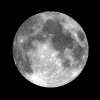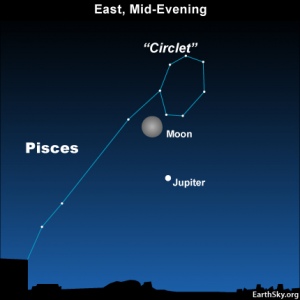Courtesy of EarthSky
A Clear Voice for Science
www.EarthSky.org

 Tonight’s sky is dominated by Jupiter and the waning gibbous moon. You can see them in the east by mid-evening tonight, after brilliant Venus has disappeared beyond the western horizon. Rising just an hour or two after sunset, Jupiter and the moon can be viewed for the rest of the night among the faint stars of the constellation Pisces the Fish.
Tonight’s sky is dominated by Jupiter and the waning gibbous moon. You can see them in the east by mid-evening tonight, after brilliant Venus has disappeared beyond the western horizon. Rising just an hour or two after sunset, Jupiter and the moon can be viewed for the rest of the night among the faint stars of the constellation Pisces the Fish.
With a bright moon passing near them, Pisces’ dim outline might not be visible except from very dark locations. Still, you might glimpse a prominent asterism – or noticeable pattern of stars – near Jupiter and the moon tonight. It is called The Circlet in Pisces.
The moon was full a couple of nights ago, but already a small portion of the moon’s edge has slipped back into the moon’s own shadow. It is hard to tell, but the moon is slightly less bright tonight than last night. Jupiter, on the other hand, is slowly increasing in brightness as it heads towards its closest approach to Earth in 12 years just next month.
Jupiter, the moon and all the other objects in the sky appear to slowly drift – more or less from east to west – as night passes. This westward drift of the stars is akin to the sun’s westward motion during the day, and, as with the sun’s motion, the stars’ motion is due to Earth’s spin beneath the sky.
The moon also moves in front of the stars, however, and you can see the moon’s motion if you watch carefully. A sharp-eyed observer who compares the relative positions of the moon, Jupiter and nearby stars at, say, 10 p.m. tonight – and then looks again just before dawn – will notice the change. The distant stars appear in a “fixed” pattern relative to each other. Over a single night, the same is essentially true for Jupiter. But because the moon is so close to Earth – and circumnavigates our sky once a month instead of once every 12 years like Jupiter – the motion of our companion world is obvious after only a few hours. In fact, the moon appears to move its own diameter eastward in just one hour. Therefore, after 6 hours – or the course of a single night – the change in the moon’s position is easy to notice.
What is the most distant human object from Earth?
Jupiter, being farther from Earth than the moon, appears to move more slowly than the moon. While you cannot easily detect its motion over just a few hours (or usually even over a few days), it does move. If you carefully plot its position tonight on star chart, and compare it to a similar plot in a month or two, the change will be easy to see.
In fact, astronomers of past centuries were originally able to rank the planets by distance based on the speed of their motions in front of the fixed stars. For example, Jupiter is brighter than Mars – but brightness does not always mean proximity to Earth. In the case of Jupiter, the planet is bright because it is so big! Yet, Jupiter moves more slowly than Mars in front of the stars. Therefore, early astronomers assumed that Jupiter was more distant.
The moon moves faster than any other natural astronomical object, which makes perfect sense for our closest neighbor in space.
![]() Written by Larry Sessions
Written by Larry Sessions
Astronomy Picture of the Day from NASA/JPL
U.S. Naval Observator Astronomical Information center